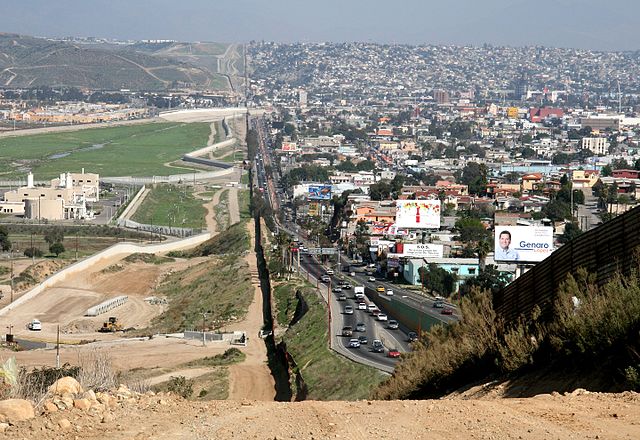
WASHINGTON — Mexico and the U.S. announced Friday that they would prohibit all “non-essential” travel across their shared border as part of efforts to control the spread of the coronavirus.
Both countries and Canada also agreed to immediately turn back anyone trying to cross their borders illegally, with U.S. officials saying that the unchecked entry of people from around the world poses a potential health risk because of the rapidly spreading virus.
“The actions we are taking together with our North American partners will save countless lives,” President Donald Trump said in announcing the measures.
Trump administration officials and Mexican Foreign Secretary Marcelo Ebrard outlined restrictions similar to those put in place earlier this week along the U.S. and Canadian border. The ban would apply to people who cross for tourism or recreation and other activities deemed “non-essential.”
“Everyone else is not expected to have any difficulties,” Ebrard told reporters in Mexico City. “We’re not talking about closing it.”
The ban, which takes effect at 11:59 p.m. Friday, does not include commercial traffic and remains in place as long as needed, officials said.
By excluding commercial traffic from the ban, the two governments substantially softened the economic effects. Also, fewer Americans are heading south because of a statewide stay-at-home order in California and a State Department warning advising Americans not to travel abroad.
Still, the restrictions are a major development along the world’s most heavily crossed border. Mexican shoppers are the lifeblood of smaller U.S. border towns, and it is common for people in both countries to cross frequently to visit family and friends.
As news of the ban spread, people like 68-year-old El Paso resident Silvia Shadden rushed to cross even if her reason could meet the definition of essential. Walking with a crutch, she returned from getting a weekly vitamin injection from a doctor in Mexico’s Ciudad Juarez that costs a fraction of what it does in the U.S.
“I went to Juarez to see the doctor and get my injection,” Shadden, who suffers from a vitamin deficiency that causes muscle atrophy, said as she returned from the U.S. border checkpoint.
In San Diego, an outlet mall catering to shoppers at the nation’s busiest border crossing was closed and people made the last of what would be considered non-essential trips under the new rules.
Robert Booker, a lifelong San Diego resident, returned from a quick trip to his tailor in Tijuana before the shutdown. “I wanted to make sure I have my clothes,” he said with a laugh. Turning serious, he said he understood the rationale for the new restrictions.
“We want the pandemic to be eradicated, so whatever it takes for the safety of all the people, that’s what we have to do,” Booker said.
Christina Rodriguez, a college student from Washington state, returned from a visit with family in Mexico — a trip that wouldn’t be allowed as of Saturday. “Everything’s up in the air,” she said. “People are just trying to go where they need to be during the isolated time.”
Acting U.S. Homeland Security Secretary Chad Wolf told reporters at the White House that the restrictions were aimed at eliminating non-essential travel while “preserving essential economic activity” at the border. American citizens and permanent legal residents would still be allowed to return to the United States.
“We want to make sure that cargo continues, trade continues, heath care workers continue to be able to traverse that border,” Wolf said. “But tourism, some recreational activities and other things needs to stop during this crisis.”
Trump said the border restrictions and the plan to immediately return anyone detained while illegally crossing are intended to curb the spread of the virus in detention facilities as well as a “mass global migration that would badly deplete the health care resources needed for our people.”
The measure to quickly turn back migrants would include those crossing illegally into the United States as well as into Canada, where some people have fled to escape U.S. enforcement efforts.
Ebrard, reacting to reports that the U.S. planned to send people from elsewhere into his country, including asylum seekers, said Mexico would only accept the return of migrants from his country and Central America.
Trump said Friday that the U.S. would send non-Mexicans “back to their own countries, not to Mexico.”
Wolf said the U.S. would send people back to their homelands but was also “working with Mexico to send additional populations back there as well.” The Department of Homeland Security did not address the apparent contradiction.
Trump also said that Mexico would suspend flights from Europe. Ebrard said his government had not yet made that decision. Mexico has reported fewer than 170 cases while the U.S. count has reached almost 11,000.
U.S. Customs and Border Protection officials say a long list of “essential” workers would be unaffected going to and from their jobs, including farm workers, restaurant and grocery store employees and bus drivers.
Keeping trade flowing, as the U.S. and Canada also agreed to do, contains the economic damage. Mexico is the U.S.’s largest trading partner, just ahead of Canada. The U.S. accounts for about 75% of Mexican exports, including autos, computers and medical devices.
Even with the exceptions, it’s a major blow to border economies. An average of 40,000 cars enter the U.S. daily from Tijuana, Mexico, at the busiest crossing in San Diego, which has a second crossing that funnels about 19,000 cars a day. About 30,000 cars enter El Paso daily from Ciudad Juarez.
The State Department on Thursday issued a new travel alert urging Americans not to go abroad under any circumstances and to return home if they are already abroad unless they plan to remain overseas. California Gov. Gavin Newsom ordered the state’s 40 million residents to stay at home, restricting non-essential movements.
———
Spagat reported from San Diego. Associated Press writers Maria Verza in Mexico City; Cedar Attanasio in El Paso, Texas; and Jill Colvin in Washington contributed to this report.